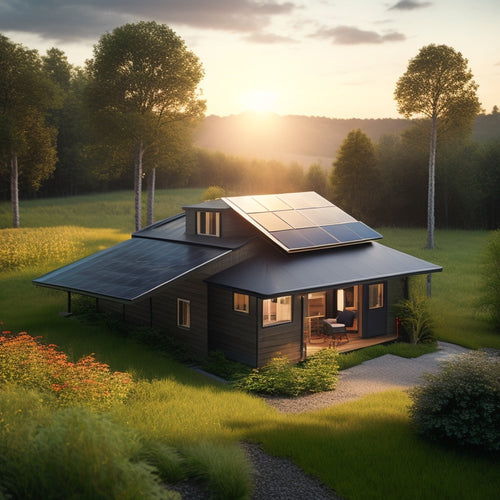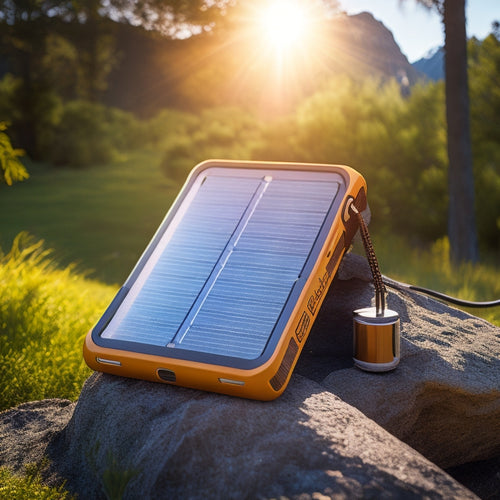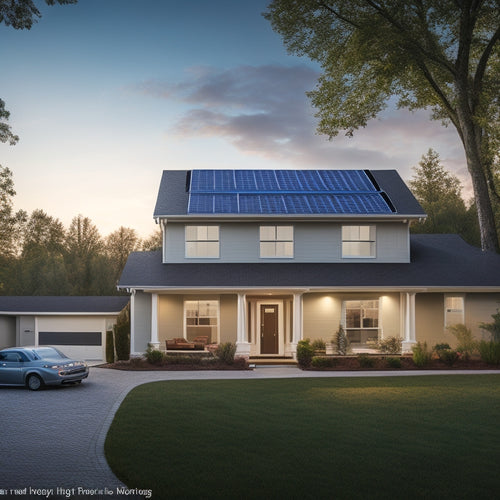
Creating Home Power Independence Systems Off Grid
Share
You're creating a home power independence system off the grid, requiring careful consideration of several essential components. Start by selecting the right solar panels, factoring in efficiency, warranty, and specifications. Next, design a battery bank system that meets your daily energy needs and desired backup duration, choosing the right battery chemistry and considering maintenance, cost, and space requirements. Properly sizing and selecting inverters and charge controllers is also vital, guaranteeing compatibility and high efficiency ratings. Now that you've got the basics covered, you're ready to explore deeper into designing a custom grid-free electrical system and installing a monitoring and tracking system to optimize performance and guarantee reliability.
Key Takeaways
- Choose the right solar panels considering types, efficiency, warranty, specifications, and manufacturer reputation for optimal energy output.
- Design a battery bank system that meets daily energy needs and desired backup duration, considering battery chemistry, maintenance, and cost vs. space.
- Select suitable inverters and charge controllers based on inverter types, size determination, efficiency ratings, compatibility, and monitoring features.
- Create a custom-designed electrical system that assesses site energy requirements, optimizes energy efficiency, and provides a consistent power supply.
- Install a monitoring and tracking system to analyze performance data, optimize energy production, and ensure system health and efficiency.
Choosing the Right Solar Panels
When selecting solar panels for your off-grid power independence system, you need to reflect on several factors to ascertain you're getting the right ones for your specific needs.
You'll want to take into account solar panel types, such as monocrystalline, polycrystalline, and thin-film, each with its own benefits and drawbacks.
Efficiency ratings are also vital, as they determine how much power your panels can generate per hour of sunlight. Look for panels with high efficiency ratings, typically above 20%, as they can greatly impact your system's overall energy output high efficiency ratings.
Additionally, it's important to review warranty options, aiming for coverage of performance, materials, and workmanship for at least 25 years to safeguard your investment.
Think about the panel's wattage, voltage, and durability. You should also check the manufacturer's warranty and certifications, such as UL and IEC.
Building a Battery Bank System
Your off-grid power independence system relies on a sturdy battery bank to store excess energy generated by your solar panels during the day for use during the night or on cloudy days.
When building a battery bank system, you'll need to evaluate the type of battery chemistry that suits your needs. Lead-acid batteries are a popular choice, but lithium-ion batteries offer higher energy density and longer lifetimes, such as the Battle Born 100Ah with a cycle life of 3000-5000 cycles.
Additionally, maintenance-free designs like Renogy Deep Cycle AGM batteries can enhance operational reliability and reduce risk of performance interruptions.
Next, determine your bank capacity by calculating your daily energy requirements and the number of days you want to be able to power your home without sunlight. A larger bank capacity provides more backup power, but increases cost and space requirements.
Selecting Inverters and Charge Controllers
Plug into the heart of your off-grid power independence system by selecting the right inverters and charge controllers. These components are vital in converting DC power from your solar panels or battery bank to AC power for your home.
When choosing an inverter, consider the type: string inverters, microinverters, or power optimizers. Each has its advantages and disadvantages, so research carefully. It's important to evaluate your daily energy usage and roof space to determine the appropriate inverter size, guaranteeing you can meet your energy requirements Energy Requirements and Sizing.
You should also consider the inverter's efficiency ratings, focusing on high peak efficiency ratings typically above 98% for maximum energy harvesting.
- Efficiency ratings: Look for high efficiency ratings to minimize energy loss.
- Compatibility: Verify the inverter and charge controller are compatible with your solar panel and battery bank configurations.
- Monitoring and control: Consider inverters and charge controllers with built-in monitoring and control capabilities for real-time system tracking.
- Certifications and warranties: Verify certifications from reputable organizations and look for thorough warranties for peace of mind.
Designing a Grid-Free Electrical System
To guarantee a seamless shift to off-grid power independence, you'll need a well-designed electrical system that satisfies your energy needs.
A thorough site assessment is essential to determine your energy requirements, considering factors like appliance loads, lighting needs, and climate. This assessment will help you identify opportunities for energy efficiency, such as using energy-efficient appliances and optimizing your system's layout.
With this information, you can design an electrical system that meets your specific needs, ensuring a reliable and efficient supply of power.
Installing a Monitoring and Tracking System
As you finalize your off-grid electrical system's design, it's time to contemplate how you'll keep tabs on its performance.
A monitoring and tracking system will provide useful observations into your system's operation, helping you optimize energy production and identify potential issues.
You'll need to install the following components:
-
Monitoring software: to collect and analyze data on your system's performance, energy production, and consumption.
-
Tracking devices: to measure voltage, current, and power output from your renewable energy sources.
-
Data loggers: to record system performance data over time, allowing you to identify trends and patterns.
- Alert systems: to notify you of any anomalies or issues that require attention.
With these components in place, you'll be well-equipped to guarantee your off-grid electrical system operates efficiently and effectively.
Frequently Asked Questions
Can I Use My Existing Electrical Panel With an Off-Grid System?
You'll need to assess your existing electrical panel's system compatibility with off-grid components; it may require panel upgrades to accommodate the new system's unique requirements, such as DC power conversion and battery integration.
How Do I Handle Power Surges and Electrical Storms?
You'll need surge protection devices to shield your system from power spikes and electrical storms. Install a whole-house surge protector and individual component protectors to guarantee thorough storm preparedness and safeguard your off-grid investment.
Are Off-Grid Systems Suitable for Areas With Heavy Shading?
Like a tree struggling to reach sunlight, you face shading challenges that can stunt your energy production. Assess your site's shading patterns and consider using specialized panels or trackers to optimize energy harvest, ensuring your off-grid system thrives despite the shade.
Can I Add to My System Over Time as Budget Allows?
As you plan your system expansion, you're wise to contemplate budget planning, allowing you to add components incrementally, ensuring a scalable design that accommodates your growing needs and financial capabilities over time.
Do I Need a Backup Generator for Prolonged Periods of Low Sunlight?
Imagine a ship steering through calm and stormy seas; you're the captain, ensuring a steady course. You'll need a backup generator as a safety net for prolonged periods of low sunlight, especially if your solar battery storage is depleted, and energy management systems can't bridge the gap.
Related Posts
-

Diy Off Grid Solar
By embracing DIY off-grid solar, you can break free from grid dependence, slashing your energy bills by up to 90% and...
-

Fastest Solar Chargers for Emergency Power
When choosing the fastest solar chargers for emergency power, you need to focus on features like rapid charging capab...
-

Cost of Solar With Battery Backup
You're investing in a solar panel system with battery backup to guarantee reliable power during outages. The cost of ...


